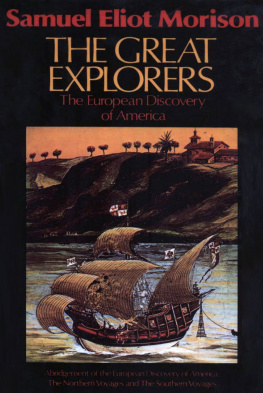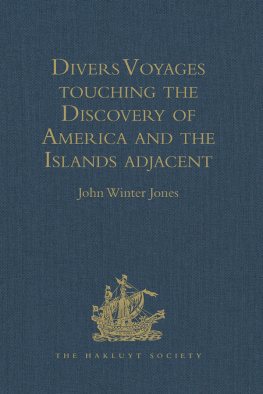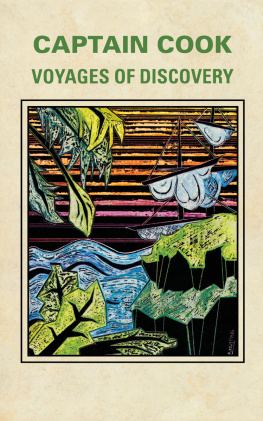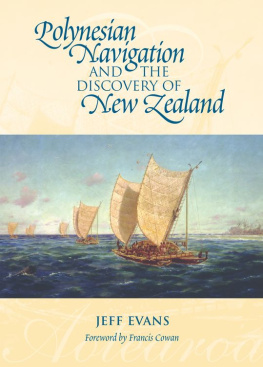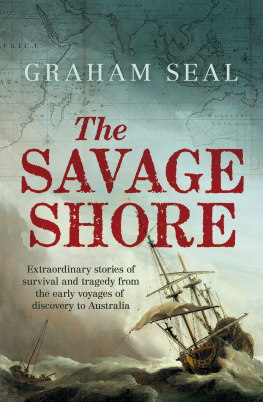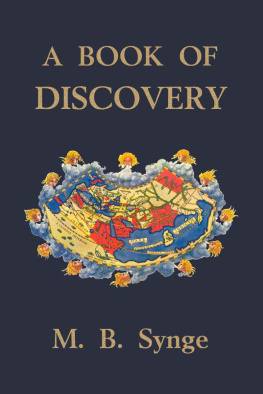Samuel Eliot Morison - The Great Explorers: The European Discovery of America
Here you can read online Samuel Eliot Morison - The Great Explorers: The European Discovery of America full text of the book (entire story) in english for free. Download pdf and epub, get meaning, cover and reviews about this ebook. year: 1986, publisher: Oxford University Press, USA, genre: Non-fiction / History. Description of the work, (preface) as well as reviews are available. Best literature library LitArk.com created for fans of good reading and offers a wide selection of genres:
Romance novel
Science fiction
Adventure
Detective
Science
History
Home and family
Prose
Art
Politics
Computer
Non-fiction
Religion
Business
Children
Humor
Choose a favorite category and find really read worthwhile books. Enjoy immersion in the world of imagination, feel the emotions of the characters or learn something new for yourself, make an fascinating discovery.
- Book:The Great Explorers: The European Discovery of America
- Author:
- Publisher:Oxford University Press, USA
- Genre:
- Year:1986
- Rating:4 / 5
- Favourites:Add to favourites
- Your mark:
- 80
- 1
- 2
- 3
- 4
- 5
The Great Explorers: The European Discovery of America: summary, description and annotation
We offer to read an annotation, description, summary or preface (depends on what the author of the book "The Great Explorers: The European Discovery of America" wrote himself). If you haven't found the necessary information about the book — write in the comments, we will try to find it.
The Great Explorers: The European Discovery of America — read online for free the complete book (whole text) full work
Below is the text of the book, divided by pages. System saving the place of the last page read, allows you to conveniently read the book "The Great Explorers: The European Discovery of America" online for free, without having to search again every time where you left off. Put a bookmark, and you can go to the page where you finished reading at any time.
Font size:
Interval:
Bookmark:
The Great Explorers
The European Discovery of America
Samuel Eliot Morison
Oxford University Press
1978 by Oxford University Press, Inc.
The Great Explorers: The European Discovery of America, first published in 1978 by Oxford University Press, Inc., is a new edition of material selected from two earlier volumes, The European Discovery of America: The Northern Voyages, A.D. 5001600, 1971 by Samuel Eliot Morison, and The European Discovery of America: The Southern Voyages, 14921616, 1974 by Samuel Eliot Morison
Library of Congress Cataloging in Publication Data
Morison, Samuel Eliot, 18871976.
The Great Explorers
Originally published in 2 v. in 197174.
Includes bibliographical references and index.
1. AmericaDiscovery and exploration.
2. Voyages and travels. I. Title.
ISBN 978-0-19-504222-1
Contents
English Ships and Seamen, 14901600
Before embarking with Cabot and his successors on their important North Atlantic voyages, my readers will wish to know what sort of a ship they used, how they built and rigged her, and what manner of men sailed her. To cover these topics with any degree of accuracy is a difficult if not impossible task. Records of English shipbuilding, design, rig, and handling for the closing years of the fifteenth century are very scarce. The situation respecting French ships is clearer, owing to the researches of Mollat, Bernard, and others; and we can also learn much from Frederic C. Lanes magisterial works on Venetian shipping.
The ships which the English, French, and other northern explorers had at their disposition around 1500 were the result of centuries of trial and error. The English, leaving the basket-like curragh to the Irish, adopted the Scandinavian knarr, which made an excellent coastwise freighter but took in too much water for offshore work.
The next development, completed by 1200, was the cog, or cogge (coque in French), invented in Germany or the Netherlands. One of the difficulties in marine research is that the same word means different things at different times. For instance, by 1600 cog had become cock or cock-boat, a ships boat propelled by oars and sail; hulk became a ship without masts, and barge became a flatboat to carry coal, or the admirals boat on a flagship.
The cog originally was a single-masted ship with one sail and a bank of oars to use to windward or in a calm, but it had four important advantages over the knarr. It was completely decked over, so that water taken in from sky or sea flowed overboard instead of having to be pumped or bailed out. It had a rudder, hung to the sternpost by iron pintles and gudgeons, and a long hardwood tiller mortised to the rudder head, affording the helmsman good leverage, while the sterncastle protected him from the elements. It had flimsy, openwork castles forward and aft, which were detachable and expendable, together with what we would call a crows nest atop the single mast, valuable both for a lookout station and for defense. It had a bowsprit, first used to stay the mast. Originally clinker-built like the knarr, the cog, owing largely to her stern rudder and big mainsail with bonnet attached, was a far better sailer and more efficient cargo carrier. Cogs, built in great numbers in the Hanseatic League seaports, ran the Scandinavian merchant fleet out of business, except for local trade in sheltered waters. A well-built cog was perfectly capable of crossing the Atlantic; I would choose her every time rather than a modern yacht of her size with a self-bailing cockpit and an open companionway ready to gobble up a following sea.
The next important development came in the early fifteenth century. A cogs hull, now carvel-built, lengthened, and provided with two more masts, became first the hourque, or hulk, then the nef, nau, or full-rigged ship. The first explorers of America used these because they had nothing better; and as a result of experience, they came to prefer the smaller ships, under 100 tuns, to the bigger. Thus, Columbus found his little Nia more serviceable than the big Santa Mara.
Methods of building were essentially the same in the Middle Ages as those described in Longfellows Building of the Ship, and as practiced in small-boat yards of England, France, Nova Scotia, and both American coasts down to 1945, when fibre-glass construction began to replace wood. Similar methods are still maintained today in other parts of the world. The builder first selects a slip at the head of tide, slightly inclined so the vessel will launch easily, and places big oak blocks evenly spaced to support her when built. Some small vessels were doubtless built by eye, but the larger ones, like those shown in the Hastings Manuscript, were carefully planned with compass and divider, the members laid down in a mould loft with chalk or charcoal, and templates of them made with thin pieces of light wood. The English builder, if he does not own an oak forest himself, arranges with another to take out the timber he wants. Oak is preferred, not only for its strength but because limbs growing from the trunk at different angles make natural crooks for the ribs or frames, the knees, and the curved stem piece. Builders would carry a wagon-load of templates into the oak grove, match them against standing trees, cut down those they wanted, and shape them with ax and adze. England then grew plenty of oak.
|
Edward Fiennes, Earl of Lincoln, Lord High Admiral, 155054 and 155885, holding a dry-card mariners compass. From painting by unknown artist. Courtesy Ashmolean Museum, Oxford. |
Venice, as Frederic C. Lane has vividly described, possessed shipyards which had many of the elements of a modern assembly plant, with gantry cranes and vehicles for bringing the component parts together. In comparison, the building yards of England and France seem to have been small and simple. The oak keel is laid with the keelson (the inside part of the keel) on top; all scarfed and bolted straight and strong. Into the keelson are mortised the ribs or frames. Crossbeams tie them to the deck, and all must be adzed into shape. Pine is preferred for side-planking and deck. These were designed to shed water quickly by being given both sheer (fore-and-aft slope) and camber (transverse slope). Iron is used for fastenings, but such timbers as keel and stern piece are bolted by trunnels, long pegs of soft wood, which will swell in the water and hold as fast as iron or copper. Spars are almost invariably spruce fir, of which, surprisingly, there were large stands in England and Scotland at this time. Parts under water are covered with black tar or pitch, the best substance then known to discourage the growth of weed and barnacles. Topsides are gaily painted in longitudinal stripes of green, blue, yellow, and red.
Whether carvel- or clinker-built, topsides and decks had to be caulked. Oakum (shredded fibers of hemp) was driven into the seams and topped off with pitch locally distilled from pine tar or imported from the Baltic. The musical ring of the caulking iron driving home the precious stuff was evident in shipbuilding then as in the early twentieth century; and if a laboring ship spewed her oakum, it was time for her crew to pray or abandon ship.
When the hull is complete, the launching takes place; that was always done with ceremony, as even today. A crowd of people attends to see it done, and lend a hand if necessary; one could have seen just such a community launching ceremony at St. Vincent, in 1969. If the vessel was not originally laid down on a cradle, one is now built under her keel, resting on greased ways, two stout wooden rails leading down to water of sufficient depth, at high tide, to float her. A priest says a few prayers, sprinkles the bows with holy water, and pronounces her chosen name, usually that of a saint or an apostle expected to look after her safety and welfare. At the moment chosen by the master shipwright, the shores which prevented the hull from toppling are knocked away by workmen with big mallets; and, if everything has been planned correctly,
Next pageFont size:
Interval:
Bookmark:
Similar books «The Great Explorers: The European Discovery of America»
Look at similar books to The Great Explorers: The European Discovery of America. We have selected literature similar in name and meaning in the hope of providing readers with more options to find new, interesting, not yet read works.
Discussion, reviews of the book The Great Explorers: The European Discovery of America and just readers' own opinions. Leave your comments, write what you think about the work, its meaning or the main characters. Specify what exactly you liked and what you didn't like, and why you think so.

